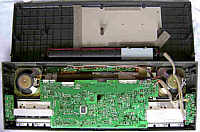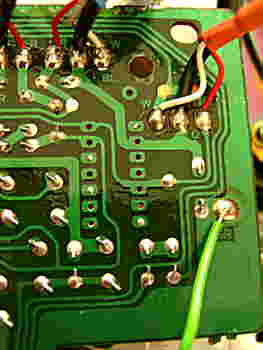CASIO
 |
|
keyboard
with warm timbres, drumpads & greatly versatile accompaniment |
|
|
This Casio keyboard from 1987(?) has lovely warm semi- analogue
sound, sample based percussion and 8 rubber drumpads. Its special feature
is the quite versatile "Super Drums" accompaniment with individually
mutable tracks, and there are even individual inputs for 8 external drumpads.
The 12 semi- OBS preset sounds and chords employ Casio's classic
"Consonant Vowel" synthesis engine (see Casio
CT-410V), which mixes 2 stair shaped waveforms with independent
volume envelopes and can make nicely warm and sonorous sounds. The 12 semi-
OBS preset rhythms are made from woody knocking medium resolution samples
(same percussion like with Casio CZ-230S);
the rhythms consist of 4 separate tracks, those each have a slide switch
for 3 variations and mute, which permits a lot of realtime variations.
Also the warm sounding accompaniments have each 3 variations and intro,
fill-in and ending and accept beyond establishment chords also wild disharmonic
note combinations. The patterns remind to Casio
CT-410V; some variations are nicely complex arranged and partly
contain arpeggio. The sensitive rubber drumpads mute a running rhythm for
a bar; the base drum pad even stops it entirely until a fill-in is started,
which can be disturbing. Unusual is that there are even 4 stereo plug jacks
to connect 8 external drumpads. There is also a primitive record/ playback
sequencer (ignores drumpad sounds). The original German retail price of
the Casio MT-520 was 449DM (about 225€, price tag on box).
main features:
-
49 midsize keys (well responding)
-
2 built-in 11cm speakers (of reasonable quality, stereo)
-
main voice polyphony up to 8 notes (only 4 with accompaniment)
-
12 semi- OBS preset sounds {piano, vibraphone, jazz organ, violin, trumpet,
funky clavi | elec. piano, elec. guitar, pipe organ, human voice, flute,
synth. sound} (selected through 6 OBS buttons + bank switch button)
-
12 semi- OBS preset rhythms {rock 1, pops, disco, swing, samba, march |
rock 2, reggae, 16 beat, slow rock, bossa nova, waltz} (selected through
6 OBS buttons + bank switch button)
-
master volume slider
-
separate rhythm & accompaniment volume sliders
-
single finger & fingered accompaniments (manual chord with rhythm off)
-
intro/ fill-in & ending buttons
-
4 "Super Drums" rhythm variation slide switches {bass drum, snare drum/
rim shot, hand clap/ bongo, cymbal/ high hat} (each 3 variations and mute)
-
3 accompaniment variations slide switch
-
tempo +/- buttons (66 steps?)
-
8 rubber drumpads {rim shot, hand clap, hi bongo, low bongo, cymbal, snare
drum, bass drum, high hat} (very responsive)
-
main & chord voice timbres based on 2 mixed stair shaped waveforms
with different digital envelopes, those are differently filtered through
capacitors.
-
percussion sound made from 8 bit medium resolution samples.
-
stereo chorus rotary speaker/ leslie simulator (based on a combination
of panning and pitch shifting)
-
complex multi-chip hardware:
-
CPU= "Hitachi HD61702A03,
7A 33" (100 pin SMD)
-
percussion IC= "OKI M6294-02,
712015, Japan" (28 pin DIL)
-
ROM= "NEC D23C64EC 029, 8652E7, Japan" (28 pin DIL, 8KB, pinout 27C256
OC)
-
sequencer SRAM= "NEC D449C-3, 8635X9201, Japan" (24 pin DIL, 2KB)
-
amp-IC= "LA4127" (20 pin DIL)
-
simple sequencer (record & playback of main & chord voice, no edit)
-
auto power-off (after 6 minutes)
-
tuning knob
-
jacks for AC- adapter, headphone, sound output, 4 drumpad jacks (3.5mm
stereo jacks, for each 2 pads)
 |
 8 drumpads can be connected.
8 drumpads can be connected. |
modifications:
-
polarity protection diode added, power supply jack polarity corrected.
notes:
The case shape of this instrument resembles much the sample based Casio
MT-540 and was likely one of the predecessors. The drumpad jacks
could be either connected with each a Casio DP-1 dual drumpad unit
or a Casio SS-1 Sound Sticks electronic drum stick (US patent 5157213,
5350881). The obscure Sound Sticks were cabled drum sticks, those vibration
sensor sends a signal by hitting any surface; a button on top of each stick
selects between the 2 contacts in each jack to switch between both sounds.
The sound quality is similarly impressive like with Casio
MT-800, although the bass of the accompaniment sounds colder. (Casio
MT-500 has warmer accompaniment.)
The preset sounds are based on filtered stair shaped waveforms and thus
don't sound perfectly realistic, but they have a nicely warm analogue timbre
and sound quite noble. It even layers 2 audio outputs for a thicker main
voice in the manner of classic Consonant-Vowel synthesis.
(I am not sure if only advanced filters are used or if possibly even
additional waveforms are involved for some timbres, because the bass range
sounds smoother, warmer and less buzzy than most other squarewave- based
Casio
keyboards.) The preset sounds all apparently employs a similar stereo
chorus like with Casio CT-410V,
although this one can not be controlled by the player and is always set
to a slow 2Hz mode. The "piano" sounds fairly real regarding the technology.
The "vibraphone" has a somewhat flute- like ethereal timbre with a dose
of chorus and weak 4Hz tremolo; the bass range is fairly dull. The "jazz
organ" is a Hammond organ imitation with mildly percussive attack
and sounds a little squawky (but not as much as with the digital Casio
SA-series keyboards), but generally quite soft and not creaky. The "violin"
has a slow attack and sounds quite realistic, although high notes are a
little thin. The "trumpet" sounds thin and hollow with delayed vibrato;
the sonorous bass range rather resembles a bassoon or oboe. The "funky
clavi." is a sort of bassy harpsichord with nicely buzzy bass range and
no sustain. Also "elec. piano" resembles a harpsichord, but sounds thinner,
has a fast fluttering tremolo and sustain. "elec. guitar" is similar but
thinner (more sitar- like) with longer sustain. "pipe organ" is the known
sonorous multipulse timbre with slow attack and short sustain that attempts
to simulate a metal pipe organ rank, but this one sounds a bit too bright
and thin. "human voice" rather resembles a wooden or very muffled metal
pipe organ rank with short sustain; it may be a "vox humana" rank, but
has very little similarity with a human voice although it sounds nicely
warm. "flute" sounds like a softly blown metal flute with fluttering tremolo
and mild reverb; the bass range sounds woody. "synth. sound" is a harsh
and massive electronic metal pipe organ timbre with percussive attack,
fast fluttering tremolo and short sustain; the timbre also resembles a
harpsichord and trumpet - only high notes play too soft in relation to
its loud and thin buzzing bass range. Unlike other that old Casio
keyboards there is neither a sustain switch nor other sound controls. The
semi- OBS preset sound buttons respond fairly fast; pressing them retriggers
the notes of held keys with the selected preset sound, which can be used
for live play tricks.
The percussion has a woody knocking style; the samples sound almost
identical with Casio SK-8 and also
the rhythms sound very similar; some of these (samba, reggae) sound quite
oriental. With the "Super Drums" slider each of the 4 tracks in a rhythm
can be switched to 3 variations or muted. Starting with all tracks muted,
you can build up a gunk structure, which is nice for tekkno- like meditative
musics. The semi- OBS preset rhythm buttons respond quite fast during rhythm
and thus can be also used for live play tricks. (The Super Drums concept
and algorithm is described in US patents 4757736 and 4972755.) The accompaniment
has 3 switchable variations and with standard chords many patterns are
similarly complex like with Casio MT-540, but unlike MT-540 this
one fortunately also accepts non- chords and the fingered accompaniment
changes depending on how many keys are pressed. Some variations feature
arpeggios, walking bass lines and other complex ornaments. Unfortunately
a running accompaniment can not be muted without disturbing the rhythm,
because the "casio chord" switch always makes the rhythm stutter when moved.
There is also a simple record/ playback sequencer that records any played
notes with chords/ accompaniment, but it can not be edited and records
no drumpad hits.
hardware details
The Casio MT-520 is based on the CPU "HD61702A03"
with external 8KB ROM "NEC D23C64EC 029" and 2KB SRAM "NEC D449C-3". The
CPU controls the percussion IC "OKI
M6294-02".
 |
 The pcb much is smaller than in MT-500.
The pcb much is smaller than in MT-500. |
  There are unused solder holes for an additional IC.
There are unused solder holes for an additional IC. |
It contains a fairly complex hardware with much analogue stuff, but the
PCB is small compared with its predecessor MT-500.
The CPU is close relative of PT-100
and
MT-88 with different software,
but because the MT-520 has a percussion IC and so doesn't need the CPU
percussion channel, it uses the surplus polyphony to layer 2 audio outputs
for a thicker main voice in the manner of classic Consonant-Vowel synthesis
and even can do a stereo chorus within the CPU. For its complex Super Drums
accompaniment it needs an a 8KB ROM and has a 2KB SRAM for sequencer. Unlike
MT-500, with ROM removed there is no sound besides drumpads (LEDs behave
normal, but it completely locks up when I try to start a rhythm).
These are the main voice filter and gain control outputs of the
HD61702A03
CPU shown in Casio CT-450 service manual. A drawing hints that the
melody alpha envelope is used for attack and beta for the rest. But the
fixed filter sections of alpha and beta subvoice seem to be the same (also
control lines wired parallel) which contradicts the original Consonant-Vowel
approach. Thus they seem to be rather used for stereo effects than timbre
changes.
|
preset sound:
|
FC4 (gain)
|
FC3 (gain) |
FC2 (filter) |
FC1 (filter)
|
| piano |
H
|
H
|
H
|
H
|
| vibraphone |
|
H
|
H
|
H
|
| jazz organ |
H
|
H
|
|
H
|
| violin |
|
|
|
|
| trumpet |
|
|
H
|
|
| funky clavi |
|
H
|
|
|
| elec .piano |
|
|
|
|
| elec. guitar |
|
|
|
|
| pipe organ |
|
|
|
|
| human voice |
|
H
|
H
|
H
|
| flute |
H
|
H
|
|
H
|
| synth. sound |
|
H
|
|
|
|
The accompaniment filters uses output pin FC5 (bass) and FC6 (chord)
for the chord and bass preset sound, depending on the selected rhythm and
bass/chord switch setting. Apparently hi means duller, but the resulting
complete table (not shown here) is rather large, so I only include here
the sound relations.
| bass: |
FC5 (filter)
|
| piano |
H
|
| guitar |
|
| organ |
H
|
| synth. sound |
H
|
| chord: |
FC6 (filter)
|
| piano |
H
|
| guitar |
|
| organ |
H
|
| synth. sound |
H
|
| celesta |
|
Said table also lists an obligato voice (can be {mute, organ, strings,
brass, human voice} - output pin unknown) for each accompaniment, which
doesn't seem to affect them. |
The stereo chorus is generated inside the CPU, which outputs the melody
voice at 2 pins to be mixed externally. Quote from CT-450 service manual:
-
Melody alpha enters negative terminal of Mixer 1
via 180k resistor and positive terminal of Mixer 2 through 33k resistor.
Thus, the right and left channel's phases are opposite.
-
Melody beta is heard from the center as it enters
the negative terminal of Mixer Amp's 1 and 2 via 12k resistors.
-
When Stereo Chorus switch is ON, either of signals
alpha or beta is delayed by frequency modulation in CPU.
The meaning of item 3 is unknown, since neither CT-450 nor MT-520 contain
a stereo chorus switch. Possibly it is part of the internal preset sound
definitions (software) or hints to an unidentified easteregg.
keyboard matrix
I haven't analyzed this huge keyboard matrix by myself, but only read the
service manual and schematics of CT-450 (same hardware class with jacks
instead of drumpads), thus there may be still unknown eastereggs. But because
many other variants are more restricted and e.g. lack Super Drums, this
still should be useful. I expect e.g. the here absent off-positions of
Super Drums sliders in row KI4.
|
40 KI1
|
41 KI2
|
42 KI3
|
43 KI4
|
44 KI5
|
45 KI6
|
46 KI7
|
47 KI8
|
|
CPU pin
|
|
in 1
|
in 2
|
in 3
|
in 4
|
in 5
|
in 6
|
in 7
|
in 8
|
in / out
|
|
o
C1
|
o
C#1
|
o
D1
|
o
D#1
|
o
E1
|
o
F1
|
O.
piano
|
R.
rock 1
|
out 1
|
83 KO1
|
o
F#1
|
o
G1
|
o
G#1
|
o
A1
|
o
A#1
|
o
B1
|
O.
vibraphone
|
R.
pops
|
out 2
|
84 KO2
|
o
C2
|
o
C#2
|
o
D2
|
o
D#2
|
o
E2
|
o
F2
|
O.
jazz organ
|
R.
disco
|
out 3
|
85 KO3
|
o
F#2
|
o
G2
|
o
G#2
|
o
A2
|
o
A#2
|
o
B2
|
O.
violin
|
R.
swing
|
out 4
|
86 KO4
|
o
C3
|
o
C#3
|
o
D3
|
o
D#3
|
o
E3
|
o
F3
|
O.
trumpet
|
R.
samba
|
out 5
|
87 KO5
|
o
F#3
|
o
G3
|
o
G#3
|
o
A3
|
o
A#3
|
o
B3
|
O.
funky clavi
|
R.
march
|
out 6
|
88 KO6
|
o
C4
|
o
C#4
|
o
D4
|
o
D#4
|
o
E4
|
o
F4
|
|
R.
select
|
out 7
|
89 KO7
|
o
F#4
|
o
G4
|
o
G#4
|
o
A4
|
o
A#4
|
o
B4
|
|
O.
select
|
out 8
|
90 KO8
|
o
C5
|
|
|
|
|
|
|
|
out 9
|
91 KO9
|
R.
bass drum I
|
R.
bass drum II
|
R.
bass drum III
|
|
|
|
|
R.
synchro
|
out 10
|
92 KO10
|
R.
snare drum I
|
R.
snare drum II
|
R.
snare drum III
|
|
|
|
R.
start/stop
|
R.
fill-in
|
out 11
|
93 KO11
|
R.
hand clap I
|
R.
hand clap II
|
R.
hand clap III
|
|
|
|
R.
tempo +
|
R.
tempo -
|
out 12
|
94 KO12
|
R.
cymbal I
|
R.
cymbal II
|
R.
cymbal III
|
|
power off
|
power on
|
memory
play
|
memory
record
|
out 13
|
66 LO1
|
C.
variation I
|
C.
variation II
|
C.
variation III
|
|
C.
off
|
C.
fingered
|
C.
casio chord
|
|
out 14
|
67 LO2
|
P.
snare
|
P.
base
|
P.
handclap
|
P.
rimshot
|
P.
low bongo
|
P.
high bongo
|
P.
cymbal
|
P.
hihat
|
out 15
|
77 LO12
|
The input lines are active-high, i.e. react on +Vs. Any functions can
be triggered by a non- locking switch in series to a diode from one "out"
to one "in" pin.
Because drumpad hits can be faster than the keyboard matrix scan cycle,
for buffering the 8 drumpad inputs each set a flipflop. To read their contents,
the CPU sets LO12 high, which makes the flipflop bank appear on the KI
lines of the keyboard matrix. Afterwards it sets LO13 high to clear the
flipflops to get ready for sensing new drumpad hits.
legend:
|
|
|
"o"
|
= keyboard key |
|
underlined
|
= function needs locking switch (i.e. stays active only so long the
switch is closed) |
|
R.
|
= preset rhythm |
|
O.
|
= preset sound ('orchestra') |
|
C.
|
= chord |
|
P.
|
= drumpad |
orange
background |
= easteregg (unconnected feature) |
|
A smaller Casio MT-520 variant with only 4 drumpads was released as
Casio
MT-220 and without drumpads as Casio MT-205/ MT-207 (aka Realistic
Concertmate-700 | both without rhythm tracks mute). The same hardware
class was also used in Casio MT-110 (with neither Super Drums nor
drumpads). A fullsize version of the MT-520 was released as Casio CT-510
(with additional pedal jack (for bass drum??)) and without drumpads as
CT-450
(additional volume- and bass drum pedal jack, lacks drum switch mute positions)
and CT-360 (mono, no drum jacks). The direct predecessor of the
MT-520 was the Casio MT-500, which
had only 4 drumpads (each switchable to 3 sounds) but even 20 preset sounds;
the MT-500 is also a nice keyboard but has other nasty flaws, thus do not
believe false claims that it would be better. A smaller Super Drums
keyboard with semi- analogue percussion (but no drumpads) was the Casio
MT-52 (all seen on eBay). Another midsize drumpad keyboard
was the Casio MT-640
(based on
MT-540 hardware, 6 rubber
drumpads, 4 effect pads, bigger speakers | I own one).
| removal
of these screws voids warranty... |
|
|
 |

|
|
| |
back
|
|



 8 drumpads can be connected.
8 drumpads can be connected.